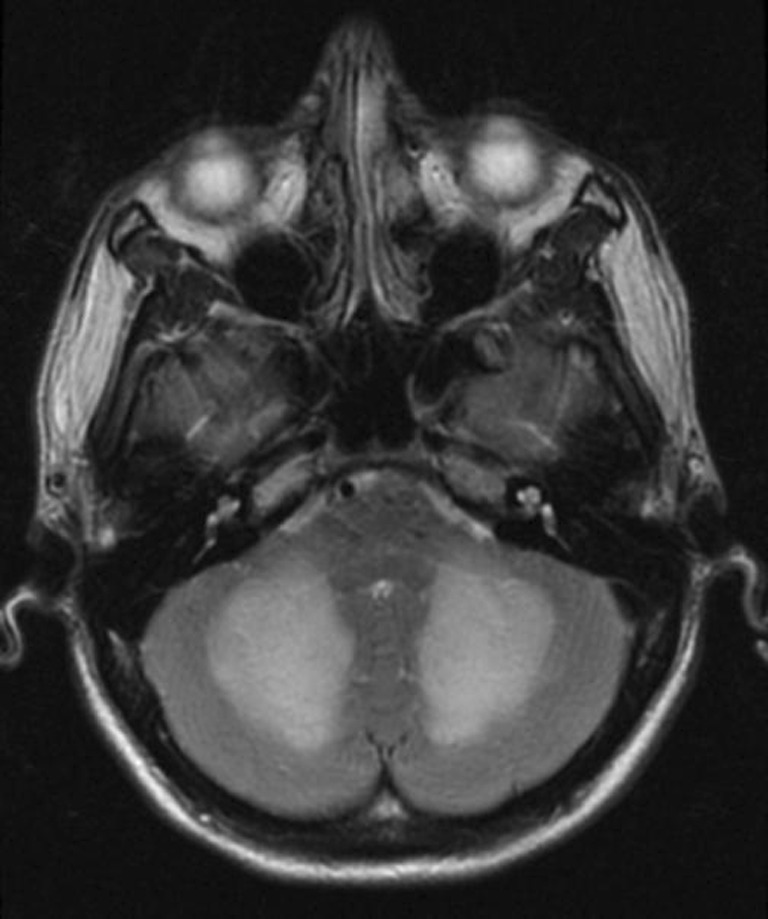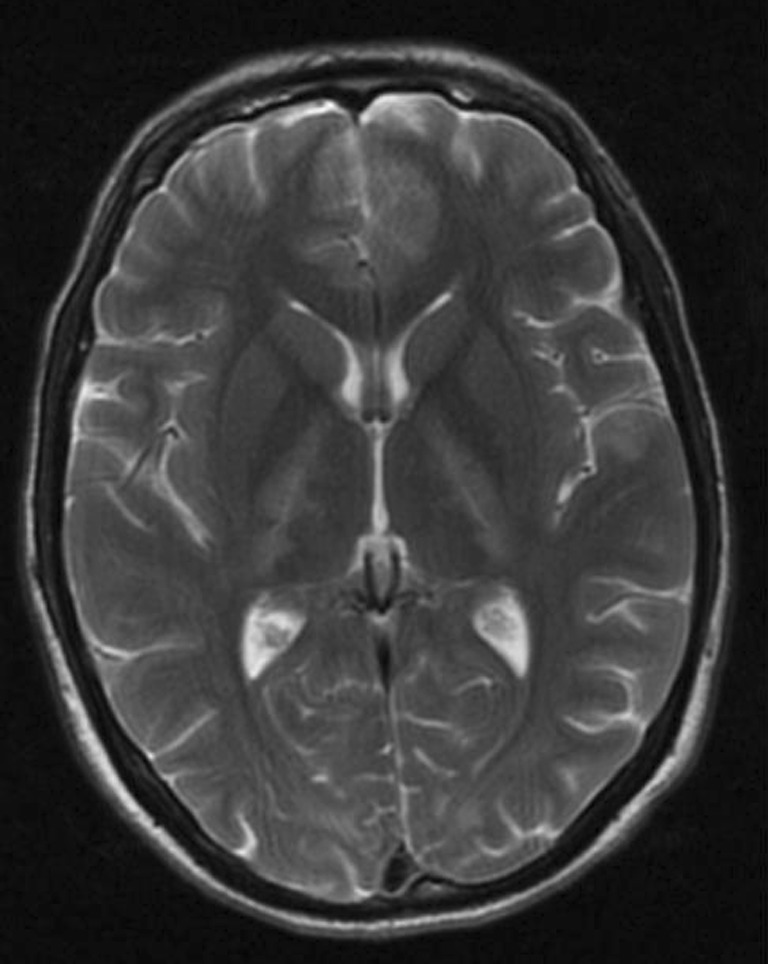“Chasing the Dragon”—Heroin-Associated Spongiform Leukoencephalopathy
A 21-year-old male presented with acute ataxia. For 1 week, he became increasingly unbalanced, clumsy, and severely dysarthric. He sustained multiple falls and had difficulty walking. He admitted to inhaling heated heroin vapors twice in the past, the last time was 1 week prior to admission. His symptoms started acutely 24 h after that. He denied injecting heroin in the past as he had a known “needle phobia”.
On examination, his speech was severely dysarthric. He demonstrated horizontal nystagmus and positive cerebellar signs bilaterally with inability to stand without assistance and falling backwards when unsupported. Serum toxicology screen was negative.
MRI revealed symmetrical white matter hyperintensities with a “C-shaped” lesion in the deep cerebellar hemispheres compatible with edema (Figs. 1 and 2). There was a loss of cerebellar folia, with inferior displacement of bilateral cerebral tonsils, compatible with developing cerebellar herniation through the foramen magnum (Fig. 2). Bilateral hypointensities involving the posterior limbs of the internal capsules were remarkable (Fig. 3).
Fig. 1.

Axial T2 MRI of the posterior fossa demonstrating bilateral hyperintensities of the cerebellar white matter
Fig. 2.

Sagittal T2 of the brain showing cerebellar white matter hyperintensity
Fig. 3.

Axial T2 MRI of the brain displaying hypointense areas involving the posterior limbs of the internal capsules
Discussion
Heroin-associated spongiform leukoencephalopathy (HASL) is a rare condition observed after inhaling heroin pyrolysate vapors [1]. “Chasing the dragon” refers to inhaling the smoke from heated heroin on a piece of foil [2]. It was first described in 1982 after an outbreak in the Netherlands [1]. This practice is becoming increasingly popular as it avoids the risks of diseases associated with parenteral administration. The toxin responsible for the condition remains unknown [1]. The disease is not reproducible in animals exposed to heroin pyrolysate [1].
The clinical presentation varies greatly, but generally includes stupor, coma, and death after a latent period of hours, days to months after the exposure [1]. Three distinct clinical stages are described. Features of the initial stage include pseudobulbar speech, motor restlessness, and cerebellar ataxia [1]. Two to 4 weeks after the initial stage, 55% of the patients go on to develop an intermediate stage consisting of rapid worsening of cerebellar symptoms, hyperactive reflexes, spastic hemiplegia or quadriplegia, myoclonus, and chorea [1]. Twenty-five percent of the intermediate-stage patients develop a terminal stage with features of stretching spasms, hypotonic areflexic paresis, akinetic mutism, central pyrexia, and eventually death [1]. Approximately one quarter of patients will enter the terminal stage [1].
A thorough investigation of the original cohort of 47 patients from Amsterdam, including autopsy for 10 of them, toxicologic analysis of heroin samples, investigation of unaffected heroin addicts, and testing of the effects of heroin vapor in animal models failed to find a toxicologic cause of the leukoencephalopathy [1, 3]. The autopsies revealed severe changes in the white matter, termed “vaculoating myelinopathy,” characterized by formation of vacuoles in the oligodendroglia, resulting in spongiform degeneration. Although several additive substances were discovered in the heroin samples, none were known or shown to produce the histopathological changes in the rat or the rabbit model [1, 3]. The authors speculated that an as-yet-unidentified toxic substance is released when heroin is heated [1, 3].
The MRI findings of HASL are unique and pathognomonic [4], presenting as diffuse increased T2 signal within the white matter tracts of the cerebellum and brainstem and the deep gray matter structures. DWI/ADC changes are usually consistent with a subacute process due to progressive vacuolization of the affected white matter. The role of antioxidants in the management of this condition remains uncertain [5].
The patient improved moderately over a course of 2 weeks and was transferred to a rehab facility. Our patient did not receive any specific treatment for HASL. He was counseled regarding abstention from heroin.
Acknowledgments
Conflict of Interest
None of the authors has any conflict of interest with the topic of this article.
Contributor Information
Tareq Kass-Hout, Phone: +1-717-5795764, FAX: +1-716-8597573.
Omar Kass-Hout, Email: omarkasshout@gmail.com.
References
- 1.Wolters EC, van Wijngaarden GK, Stam FC, et al. Leucoencephalopathy after inhaling "heroin" pyrolysate. Lancet. 1982;2:1233–1237. doi: 10.1016/S0140-6736(82)90101-5. [DOI] [PubMed] [Google Scholar]
- 2.Dikotter F, Laamann L, Xun Z. Narcotic culture: a history of drugs in China. Chicago: University of Chicago Press; 2004. p. 162. [Google Scholar]
- 3.Bartlett E, Mikulis DJ. Chasing "chasing the dragon" with MRI: leukoencephalopathy in drug abuse. Br J Radiol. 2005;78:997–1004. doi: 10.1259/bjr/61535842. [DOI] [PubMed] [Google Scholar]
- 4.Keogh CF, Andrews GT, Spacey SD, Forkheim KE, Graeb DA. Neuroimaging features of heroin inhalation toxicity: “chasing the dragon”. AJR Am J Roentgenol. 2003;180:847–50. doi: 10.2214/ajr.180.3.1800847. [DOI] [PubMed] [Google Scholar]
- 5.Gacouin A, et al. Reversible spongiform leucoencephalopathy after inhalation of heated heroin. Intensive Care Med. 2003;29:1012–1015. doi: 10.1007/s00134-003-1691-5. [DOI] [PubMed] [Google Scholar]


